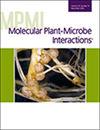Francois Vasseur, Patricia Baldrich, Tamara Jiménez-Góngora, Luis Villar-Martin, Detlef Weigel, Ignacio Rubio-Somoza
求助PDF
{"title":"miR472 Deficiency Enhances <i>Arabidopsis thaliana</i> Defense Without Reducing Seed Production.","authors":"Francois Vasseur, Patricia Baldrich, Tamara Jiménez-Góngora, Luis Villar-Martin, Detlef Weigel, Ignacio Rubio-Somoza","doi":"10.1094/MPMI-02-24-0011-R","DOIUrl":null,"url":null,"abstract":"<p><p>After having co-existed in plant genomes for at least 200 million years, the products of microRNA (miRNA) and nucleotide-binding leucine-rich repeat protein (NLR) genes formed a regulatory relationship in the common ancestor of modern gymnosperms and angiosperms. From then on, DNA polymorphisms occurring at miRNA target sequences within NLR transcripts must have been compensated by mutations in the corresponding mature miRNA sequence. The potential evolutionary advantage of such regulation remains largely unknown and might be related to two nonexclusive scenarios: (i) miRNA-dependent regulation of NLR levels might prevent defense mis-activation with negative effects on plant growth and reproduction or (ii) reduction of active miRNA levels in response to pathogen-derived molecules (pathogen-associated molecular patterns [PAMPs] and silencing suppressors) might rapidly release otherwise silent NLR transcripts for rapid translation and thereby enhance defense. Here, we used <i>Arabidopsis thaliana</i> plants deficient for miR472 function to study the impact of releasing its NLR targets on plant growth and reproduction and on defense against the fungal pathogen <i>Plectosphaerella cucumerina</i>. We show that miR472 regulation has a dual role, participating both in the tight regulation of plant defense and growth. MIM472 lines, with reduced active miR472, are more resistant to pathogens and, correlatively, have reduced relative growth compared with wild-type plants, although the end of their reproductive phase is delayed, exhibiting higher adult biomass and similar seed yield as the wild-type. Our study highlights how negative consequences of defense activation might be compensated by changes in phenology and that miR472 reduction is an integral part of plant defense responses. [Formula: see text] Copyright © 2024 The Author(s). This is an open access article distributed under the CC BY-NC-ND 4.0 International license.</p>","PeriodicalId":19009,"journal":{"name":"Molecular Plant-microbe Interactions","volume":" ","pages":"819-827"},"PeriodicalIF":3.4000,"publicationDate":"2024-12-01","publicationTypes":"Journal Article","fieldsOfStudy":null,"isOpenAccess":false,"openAccessPdf":"","citationCount":"0","resultStr":null,"platform":"Semanticscholar","paperid":null,"PeriodicalName":"Molecular Plant-microbe Interactions","FirstCategoryId":"99","ListUrlMain":"https://doi.org/10.1094/MPMI-02-24-0011-R","RegionNum":3,"RegionCategory":"生物学","ArticlePicture":[],"TitleCN":null,"AbstractTextCN":null,"PMCID":null,"EPubDate":"2024/12/17 0:00:00","PubModel":"Epub","JCR":"Q2","JCRName":"BIOCHEMISTRY & MOLECULAR BIOLOGY","Score":null,"Total":0}
引用次数: 0
引用
批量引用
Abstract
After having co-existed in plant genomes for at least 200 million years, the products of microRNA (miRNA) and nucleotide-binding leucine-rich repeat protein (NLR) genes formed a regulatory relationship in the common ancestor of modern gymnosperms and angiosperms. From then on, DNA polymorphisms occurring at miRNA target sequences within NLR transcripts must have been compensated by mutations in the corresponding mature miRNA sequence. The potential evolutionary advantage of such regulation remains largely unknown and might be related to two nonexclusive scenarios: (i) miRNA-dependent regulation of NLR levels might prevent defense mis-activation with negative effects on plant growth and reproduction or (ii) reduction of active miRNA levels in response to pathogen-derived molecules (pathogen-associated molecular patterns [PAMPs] and silencing suppressors) might rapidly release otherwise silent NLR transcripts for rapid translation and thereby enhance defense. Here, we used Arabidopsis thaliana plants deficient for miR472 function to study the impact of releasing its NLR targets on plant growth and reproduction and on defense against the fungal pathogen Plectosphaerella cucumerina . We show that miR472 regulation has a dual role, participating both in the tight regulation of plant defense and growth. MIM472 lines, with reduced active miR472, are more resistant to pathogens and, correlatively, have reduced relative growth compared with wild-type plants, although the end of their reproductive phase is delayed, exhibiting higher adult biomass and similar seed yield as the wild-type. Our study highlights how negative consequences of defense activation might be compensated by changes in phenology and that miR472 reduction is an integral part of plant defense responses. [Formula: see text] Copyright © 2024 The Author(s). This is an open access article distributed under the CC BY-NC-ND 4.0 International license.
miR472 缺乏会增强拟南芥的防御能力,但不会降低种子产量。
在植物基因组中共存了至少 2 亿年之后,microRNA(miRNA)和核苷酸结合富亮氨酸重复蛋白(NLR)基因的产物在现代裸子植物和被子植物的共同祖先中形成了一种调控关系。从那时起,NLR 转录本中 miRNA 目标序列的 DNA 多态性必须通过相应成熟 miRNA 序列的突变来补偿。这种调控的潜在进化优势在很大程度上仍不为人所知,可能与两种非排他性的情况有关:依赖 miRNA 的 NLR 水平调控可能会防止对植物生长和繁殖产生负面影响的防御误动作;或者在响应病原体衍生分子(PAMPS 和沉默抑制因子)时活性 miRNA 水平的降低可能会迅速释放原本沉默的 NLR 转录本,使其快速翻译,从而增强防御能力。在这里,我们利用 miR472 功能缺陷的拟南芥植物研究了释放其 NLR 目标对植物生长和繁殖以及对真菌病原体 Plectospharaella cucumerina 的防御的影响。我们发现,miR472 的调控具有双重作用,它同时参与植物防御和生长的严格调控。活性 miR472 减少的 MIM472 株系对病原体的抵抗力更强,与野生型植物相比,其相对生长量也相应减少,但其生殖期结束的时间却推迟了,表现出更高的成株生物量和与野生型相似的种子产量。我们的研究突显了防御激活的负面影响如何可能通过物候变化得到补偿,以及 miR472 的减少是植物防御反应不可或缺的一部分。
本文章由计算机程序翻译,如有差异,请以英文原文为准。

 求助内容:
求助内容: 应助结果提醒方式:
应助结果提醒方式:


